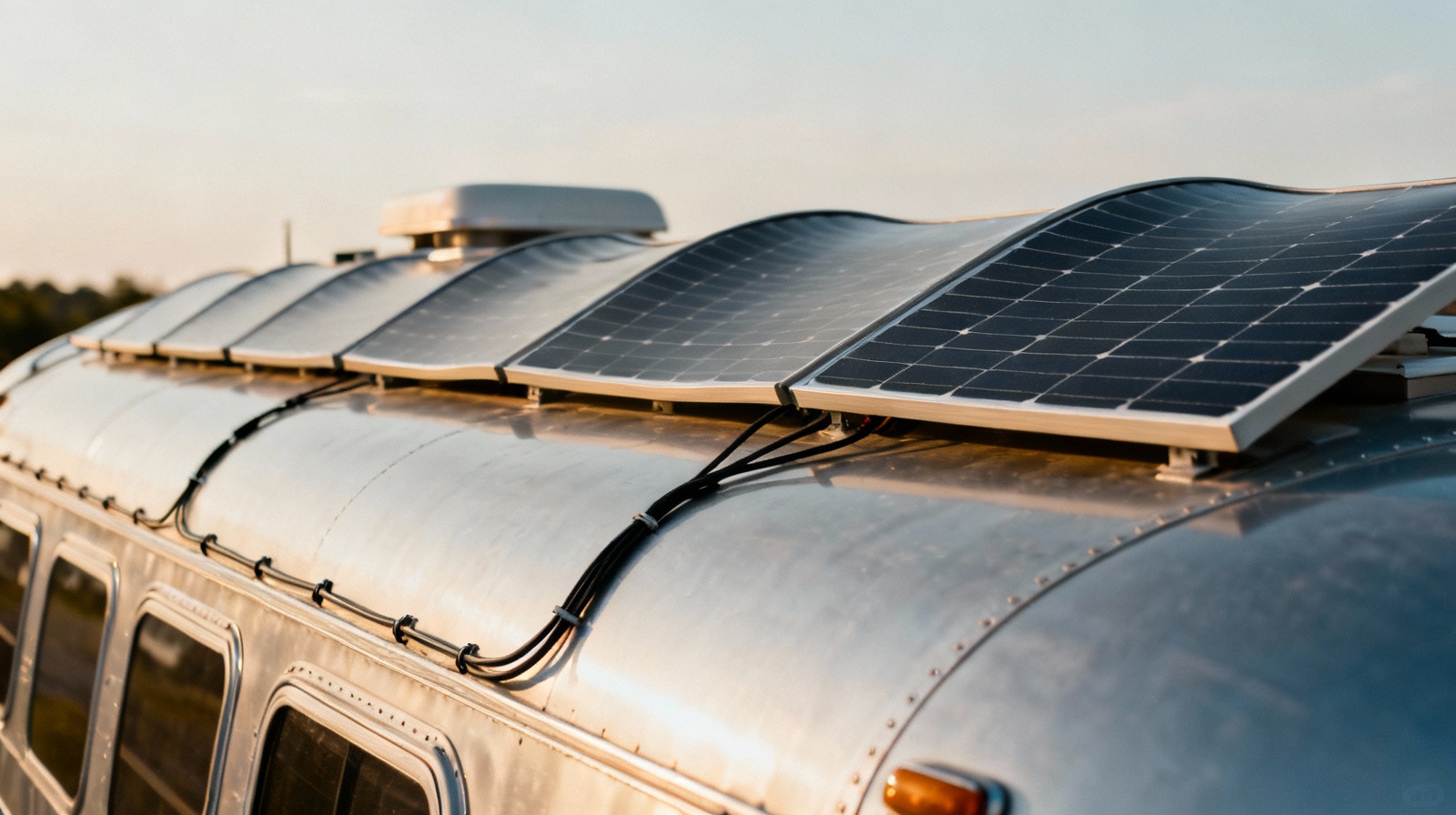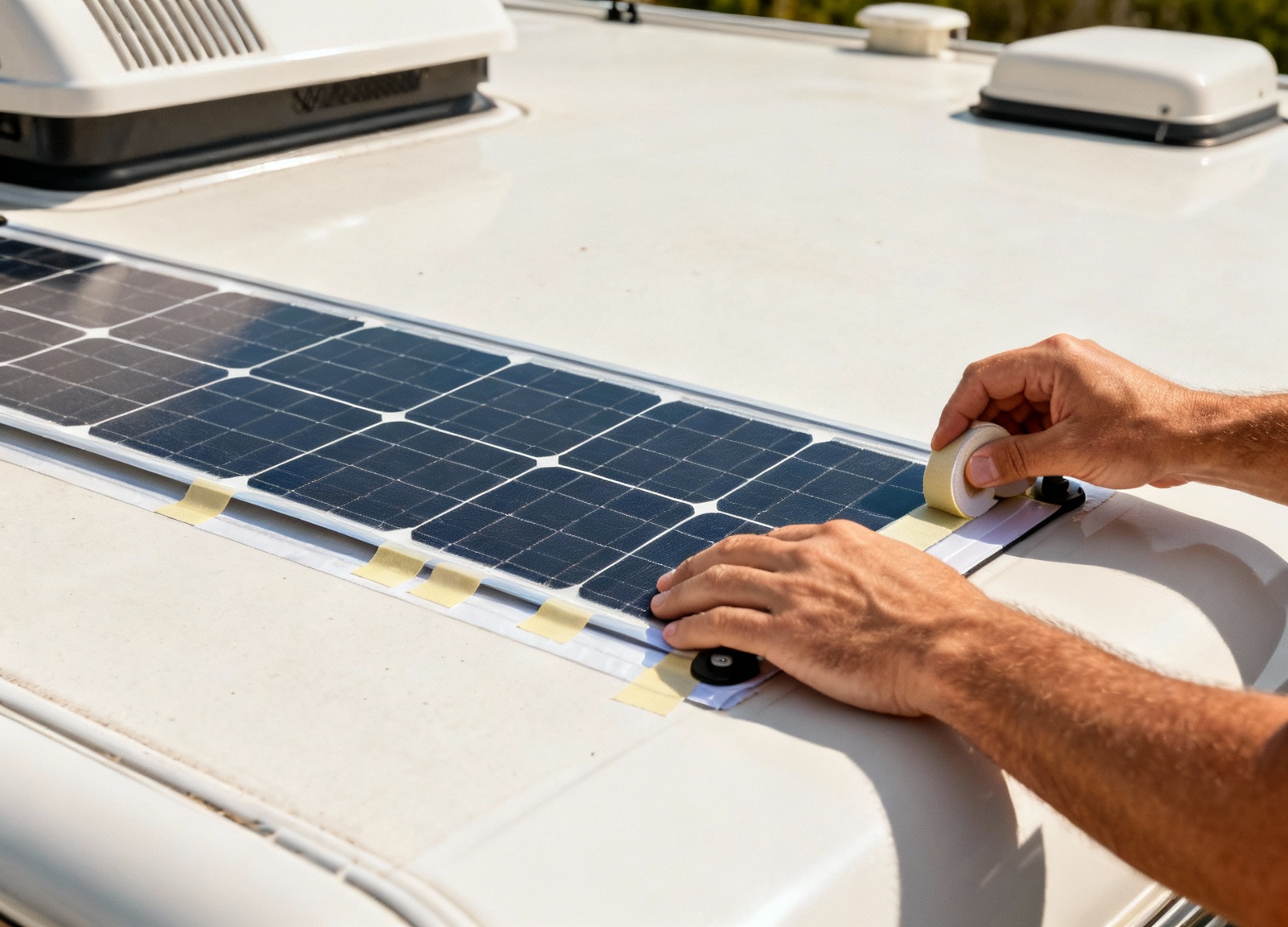
Best RV Solar Picks

#1 Renogy 200W Flexible Monocrystalline Panel
Key Specs: 200W output, 248-degree arc flexibility, ~7–8 lbs weight, ETFE coating. View on Amazon
- Pro: Still lightweight for its size (~7–8 lbs) makes roof installation manageable solo
- Pro: ETFE lamination provides superior UV resistance compared to PET alternatives
- Pro: Can flex up to 248 degrees for curved Airstream roofs
- Con: Requires careful thermal management to prevent delamination
- Con: 15-20% efficiency loss compared to rigid panels in high heat
#2 BougeRV 200W CIGS Thin Film Panel
Key Specs: 200W rated power, CIGS technology, 360-degree flexibility, 5.5 lbs. View on Amazon
- Pro: CIGS technology performs better in partial shade than monocrystalline
- Pro: Can literally wrap around curved surfaces without damage
- Pro: Maintains efficiency better in extreme heat (above 140°F surface temp)
- Con: Lower overall efficiency at 14-16% versus 19-21% for mono panels
- Con: Requires 25% more roof space for equivalent wattage
#3 Rich Solar 100W Flexible Panel Kit
Key Specs: 100W monocrystalline, includes 20A PWM controller, complete wiring kit.
- Pro: Complete starter kit eliminates component compatibility guesswork
- Pro: Budget-friendly entry point at under $200 total
- Pro: Pre-crimped MC4 connectors save installation time
- Con: PWM controller wastes 20-30% potential power versus MPPT
- Con: 100W insufficient for most boondocking needs beyond phone charging
#4 ALLPOWERS 200W Semi-Flexible Panel
Key Specs: 200W output, semi-flexible design (30-degree max bend), 8.8 lbs, junction box included. View on Amazon
- Pro: Semi-rigid construction balances flexibility with durability
- Pro: Integrated junction box simplifies wiring connections
- Pro: Better heat dissipation than fully flexible panels
- Con: Limited 30-degree bend radius restricts mounting options
- Con: Heavier than true flexible panels at nearly 9 pounds
#5 Dokio 100W Foldable Solar Suitcase
Key Specs: 100W portable, folds to 21×28 inches, includes PWM controller, 5.5 lbs total. View on Amazon
- Pro: Portable design allows ground deployment for optimal sun angle
- Pro: No permanent installation preserves roof warranty
- Pro: Can supplement existing roof systems during high-demand periods
- Con: Requires manual positioning throughout the day
- Con: Vulnerable to theft when deployed unattended
#6 SunPower 170W Flexible Panel
Key Specs: 170W Maxeon cell technology, 23% efficiency, 4.2 lbs, 5-year warranty.
- Pro: Industry-leading 23% efficiency maximizes power per square foot
- Pro: Maxeon cells resist microcracks better than standard cells
- Pro: Backed by 5-year warranty versus typical 1-2 years
- Con: Premium pricing at 2-3x cost of budget panels
- Con: Overkill for weekend warriors who camp with hookups
#7 HQST 100W Flexible Panel
Key Specs: 100W monocrystalline, 2.65 lbs ultralight, PET surface, budget option.
- Pro: Lightest panel tested at under 3 pounds
- Pro: Aggressive pricing makes multiple panel arrays affordable
- Pro: Thin 0.08-inch profile minimizes wind resistance
- Con: PET lamination degrades faster than ETFE in UV exposure
- Con: Reports of delamination after 18-24 months in desert climates
Which One Should You Buy?
Your RV lifestyle dictates the optimal solar solution.
Weekend warriors who primarily camp at developed campgrounds with electrical hookups need minimal solar—the Rich Solar 100W kit provides emergency backup power for essentials when shore power fails. This setup handles LED lights, phone charging, and a laptop for under $200 total investment. It won’t run your air conditioner, but it keeps the basics running during unexpected outages.
Part-time boondockers spending 3-7 days off-grid monthly should target 300-400W of solar capacity. Two Renogy 175W flexible panels paired with a quality MPPT controller and 200Ah of lithium batteries supports moderate energy use including a 12V refrigerator, water pump, lights, and device charging. This configuration handles typical spring and fall camping without generator backup. The flexible panels conform to curved roofs while adding minimal weight—critical for older RVs near their cargo capacity.
Full-time RVers require serious power.
Most need 600W minimum, with many installing 800-1000W systems. Here, efficiency matters more than weight savings. Consider mixing panel types: SunPower’s high-efficiency panels for maximum roof utilization, supplemented by a Dokio portable suitcase for winter camping when sun angles challenge roof-mounted arrays. The portable panel also enables parking in shade while deploying solar in sunny clearings—extending comfortable camping seasons. This hybrid approach costs more initially but provides flexibility that rigid roof-only systems can’t match.
Climate considerations override brand preferences. Desert dwellers should prioritize CIGS technology like BougeRV panels that maintain efficiency at extreme temperatures where monocrystalline panels struggle. Pacific Northwest campers benefit from panels optimized for diffuse light conditions, as they’ll rarely see direct sunlight through the persistent cloud cover. Coastal RVers need marine-grade components with enhanced corrosion resistance—salt air destroys standard electrical connections within months.
Budget-conscious buyers should understand the false economy of cheap panels. While HQST panels cost half what Renogy charges, premature failure means replacement costs, installation labor, and camping trips ruined by power failures. However, if you’re selling your RV within two years, premium panels won’t return their investment. Match component quality to your ownership timeline and usage patterns.
Safety & Common Mistakes

Flexible panel installation seems deceptively simple, leading to expensive failures.
The most critical mistake involves improper thermal management. Flexible panels glued directly to RV roofs can reach 180°F surface temperatures, causing adhesive failure, cell degradation, and delamination. Always maintain an air gap using VHB tape spacers or aluminum angle brackets. This 0.5-inch gap reduces panel temperature by 20-30°F, extending lifespan from 2-3 years to 5-7 years. Some installers use corrugated plastic sheets as standoffs—cheap, effective, and readily available at any hardware store.
Wiring errors cause fires. RV solar systems require DC-rated components throughout—using AC-rated breakers or switches creates arc flash hazards. Every connection point needs proper strain relief; vibration during travel loosens connections, generating resistance heat that can exceed safe operating temperatures. MC4 connectors must click audibly when mating. Partial connections appear functional but develop hot spots exceeding 200°F. Use an infrared thermometer to check connections after the first week of use, then monthly thereafter.
Controller sizing mistakes waste money and power.
PWM controllers lose 20-30% of potential power from panels—fine for small systems but wasteful at scale. MPPT controllers cost more initially but pay for themselves within 18 months through improved harvest. Size controllers for 25% above panel rating to handle edge-of-cloud events where irradiance briefly exceeds panel ratings. A 400W array needs a 30A MPPT controller minimum, not the 25A model that seems adequate. Remember that controllers rated in amps refer to output current, not input—check both specifications.
Grounding oversights create dangerous conditions. RV chassis grounds differ from residential grounding—never connect solar negative to chassis ground without understanding your RV’s electrical architecture. Some RVs use floating grounds, others tie negative to chassis. Incorrect grounding causes galvanic corrosion, destroying expensive components within months. Consult your RV’s electrical schematic or hire an RVIA-certified technician for ground connections. This isn’t a place for guesswork.
Shade impacts exceed expectations.
A single shaded cell can reduce panel output by 75%. Tree shadows, air conditioner covers, and even bird droppings create power-killing shade. Bypass diodes help but don’t eliminate the problem. Plan panel layouts avoiding all permanent shade sources. Consider smaller panels in parallel rather than large panels in series—parallel configurations tolerate partial shading better. Some RVers install micro-inverters on each panel to maximize harvest despite shading, though this adds complexity and cost.
Installation Best Practices

Successful flexible panel installation starts with proper surface preparation. Clean the mounting area with isopropyl alcohol, removing all wax, dirt, and oxidation. Any contamination prevents proper adhesion, leading to premature failure. For fiberglass roofs, light sanding with 220-grit paper improves adhesion. Aluminum roofs need special primers designed for non-porous surfaces.
Temperature matters during installation.
Install panels when ambient temperature sits between 60-85°F. Colder temperatures prevent adhesives from curing properly, while excessive heat causes premature bonding before proper positioning. Plan installations for early morning in summer, midday in spring or fall. Keep panels shaded until ready to install—pre-heated panels become difficult to handle and position accurately.
Cable management prevents failures. Use proper cable glands for roof penetrations, not simple caulk around wires. UV-resistant cable ties or adhesive-backed cable channels keep wiring organized and protected. Leave service loops at connection points—thermal expansion and contraction will stress tight cables. Run wiring along existing roof features when possible to minimize new penetrations.
Document everything. Photograph each step of installation, including serial numbers, wiring routes, and connection points. Create a system diagram showing panel layout, controller settings, and fuse ratings. This documentation proves invaluable for troubleshooting, warranty claims, and eventual system upgrades. Store copies both digitally and in your RV’s manual collection.
Recommended Gear

- Victron SmartSolar MPPT 100/30 — Bluetooth monitoring, 30A capacity handles up to 440W on 12V systems. View on Amazon
- Renogy 200W Flexible Panel — Best balance of weight, efficiency, and durability for curved RV roofs. View on Amazon
- Battle Born 100Ah LiFePO4 — Drop-in replacement for lead-acid, 3000+ cycles, built-in BMS protection. View on Amazon
- Victron BMV-712 Battery Monitor — Bluetooth connectivity, tracks state-of-charge, historical data logging. View on Amazon
- Blue Sea Systems 285 Circuit Breaker — DC-rated protection, ignition protected for RV use. View on Amazon
FAQs
- What’s the 33% rule for RV solar? Never discharge batteries below 50% capacity, size your solar to replace 33% of battery capacity daily, and add 33% overhead to your calculated power needs. This conservative approach prevents system strain during cloudy periods while ensuring batteries last their rated lifespan. For a 200Ah battery bank, aim for panels producing 66Ah daily (roughly 300W of panels in average conditions).
- Can flexible panels handle hail? Most flexible panels lack the tempered glass protection of rigid panels, making them vulnerable to hail damage above 1-inch diameter. ETFE-coated panels offer better impact resistance than PET versions but still can’t match rigid panel durability. Comprehensive RV insurance should cover solar panel hail damage, but check your policy specifics. In hail-prone regions, consider removable mounting systems allowing panel storage during severe weather.
- Why do flexible panels fail faster than rigid? Heat dissipation drives the difference. Rigid panels maintain a natural air gap beneath them, while flexible panels trap heat against the roof surface. This 30-40°F temperature difference accelerates polymer degradation, adhesive failure, and semiconductor junction breakdown. Additionally, flexible panels expand and contract more with temperature changes, stressing internal connections. Expect 5-7 year lifespan versus 20-25 years for quality rigid panels.
- Should I mix panel brands and wattages? Mixing panels requires careful planning. Parallel connections tolerate different wattages but panels should have similar voltage ratings (within 5%). Series connections demand identical current ratings or the lowest-current panel bottlenecks the entire string. Never mix cell technologies (monocrystalline with CIGS) in the same array. When expanding existing systems, matching exact specifications proves nearly impossible—add new panels as a separate array with dedicated controller.
